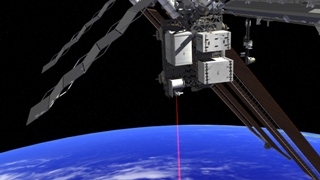Dec 10 2014
You may know opals as fiery gemstones, but something special called OPALS is floating above us in space. On the International Space Station, the Optical Payload for Lasercomm Science (OPALS) is demonstrating how laser communications can speed up the flow of information between Earth and space, compared to radio signals.
 This artist's rendition shows OPALS operating from the International Space Station. Credit: NASA/JPL-Caltech
This artist's rendition shows OPALS operating from the International Space Station. Credit: NASA/JPL-Caltech
"OPALS has shown that space-to-ground laser communications transmissions are practical and repeatable," said Matthew Abrahamson, OPALS mission manager at NASA's Jet Propulsion Laboratory in Pasadena, California. "As a bonus, OPALS has collected an enormous amount of data to advance the science of sending lasers through the atmosphere. We look forward to continuing our testing of this technology, which sends information to and from space faster than with radio signals."
Laser communication science has Earth benefits, too. Faster downlinks from space could mean people receive higher-definition video from both satellites orbiting our planet and spacecraft farther into space, including NASA's Mars rovers. Laser communication technology also has the potential to provide faster Internet connections in remote areas on Earth. Anyone with an interest in high-speed, high-quality downloads may benefit from this technology -- including researchers, engineers and consumers.
OPALS has completed its four-month prime mission. In the next phase of the mission, OPALS scientists will look at how adaptive optics can increase the efficiency of the optical communications link. The lessons learned from OPALS will make future optical links more robust and reliable.
OPALS launched to the space station aboard a SpaceX Dragon cargo capsule in April. The payload was able to establish an optical communications link when its laser locked onto a ground beacon emitted by the Optical Communications Telescope Laboratory's ground station at JPL's Table Mountain Observatory in Wrightwood, California. The technology uses a beacon with four individual lasers to average the effects of atmospheric turbulence.
"Four lasers from the ground station travel through the sky toward the space station. Under clear, dark background conditions, it's very easy for the payload to acquire the ground beacon. Daylight conditions have proven more challenging, but we are working on increasing capabilities during the day as well, through software enhancements," Abrahamson said.
OPALS had 18 successful passes from Table Mountain: nine during daylight and nine during nighttime. The payload was able to track the ground receiver with stunning accuracy.
"At times, weather was a challenge, with clouds obscuring the lasers. The payload showed the capability to reacquire the signal after cloud blockage," Abrahamson said.
OPALS had its first success on June 5, a night pass lasting 148 seconds. It sent a copy of the same video (with the message, "Hello, World!") every 3.5 seconds. With traditional downlink methods, the 175-megabit video would take 10 minutes to transmit.
OPALS has also downlinked text. Lewis Carroll's "Alice's Adventures in Wonderland" was transmitted multiple times from the payload to the ground in June.
In July, OPALS sent a high-definition video of the 1969 Apollo 11 moon landing, honoring the 45th anniversary of that historic event. This was the first video uploaded from the ground to OPALS after launch.
"It took 12 hours to uplink the video using existing infrastructure, and OPALS downlinked it in just seven seconds," Abrahamson said.
The OPALS team downlinked engineering data, between 200 and 300 megabytes in size. Using standard methods, it would take about three hours to send this data; but with OPALS it took only 20 seconds. The data were reconstructed completely without encoding, highlighting the optical link's low bit-error rate -- the rate of errors relative to the total number of bits.
International collaboration has also been important to the mission. OPALS attempted a handful of passes with the German Aerospace Center's ground station in Oberpfaffenhofen, Germany, and with the European Space Agency's ground station in Tenerife, Spain. These passes had varying levels of success.
"We're finding that differing weather patterns and geometry variations are proving to be challenging. We've had a half dozen or so pass attempts with varying levels of success, and we are looking to continuing these collaborations in the future," Abrahamson said.
"OPALS is going to change the way we communicate with and build spacecraft in the future," Abrahamson said.
The OPALS project office is based at JPL. The California Institute of Technology manages JPL for NASA.